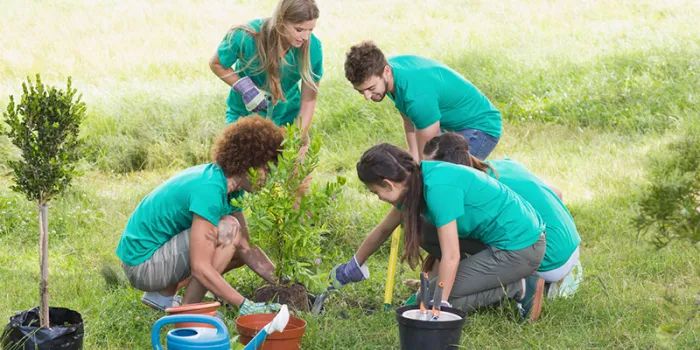Your next workout is waiting just outside your door. Grab a rake, a push lawn mower and some gardening tools, and get fit in your yard. While you shape up your property, your yard work will help get you in shape, too. “Raking gives you a great upper-body workout, and that’s something a lot of people don’t get,” says physical therapist Grace Hernandez, PT, of the Children’s Hospital of Orange County Hemophilia Program in Orange, California.
Raking leaves, pushing a lawn mower, clipping your hedges, weeding your garden and other outdoor chores not only make you stronger, they’ll slim you down as well. A 155-pound person burns nearly 300 calories for every hour spent raking. Using a manual mower, the same person will zap close to 400 calories in 60 minutes. Gardening can be nearly as vigorous, according to stats from the Wisconsin Department of Health and Family Services. “It’s a real workout,” says Hernandez.
However, yard work should be a part of an overall exercise routine. “You shouldn’t rely on yard work as your sole form of exercise, but it certainly would make a nice supplement to exercises you already do,” says Luke Smith, PT, DPT, CEAS, CSCS, a physical therapist at Thomas Jefferson University Hospital in Philadelphia.
Body mechanics
Anyone new to exercise and to yard work should see a physical therapist (PT) before getting started. Your PT will help you learn safe ways to perform each of the tasks you want to accomplish.
“Good body mechanics are crucial,” says Hernandez. “If you have an elbow problem, for example, your therapist could show you a better way to lift and carry things so that you use more of your shoulder, back and leg muscles,” she says. Proper mechanics decrease stress on joints, she adds.
How much you carry is just as important as how you carry it. “Instead of carrying big bags of sod, separate them into smaller loads,” Hernandez says. Make multiple trips with your wheelbarrow, so all the weight isn’t in one load. She recommends garden wagons for hauling heavy loads and roller stands for cumbersome plants.
When you’re working in the yard, try to keep a neutral body position, says Smith. That means your ears should be above your shoulders, which should align with your hips. “You want to minimize the bending and twisting as much as you can,” he says. “This is especially important for people with more severe forms of hemophilia who need to be extra cautious about joint strain.”
Another tip: Treat your rake as a dance partner, Smith says. Hold it as close to your body as possible when you work. Rather than stretching out to drag leaves to you, step toward the leaves so that you don’t have to reach very far.
Also, avoid kneeling in the dirt, Smith cautions. Instead, consider purchasing a gardening bench. It will allow you to get close to the earth without straining your knees.
Taking precautions
Yard work will make you sweat, so keep water handy to stay hydrated. Protect yourself from the sun by wearing a hat with a wide brim and slather on the sunscreen. Gardening gloves sized to fit your hands can help prevent blisters from using a rake, manual mower and other tools.
Don’t try to do too much at once, though. “Listen to what your body is telling you,” says Smith. You can avoid injury if you work on one task for a short while, then take a break or switch to something different. This is especially important if you have a problem joint. If you have a bad shoulder, rake only a few minutes at a time before resting for a bit, says Smith.
To get the most out of your yard work workout, use manual tools. The extra effort they require will burn more calories and help you build more muscle. But electric tools still provide benefits. “Even if you use electric leaf blowers or clippers or mowers, you can still burn calories just by holding and moving those power tools,” says Hernandez. “You can get fit just working in the yard.”

